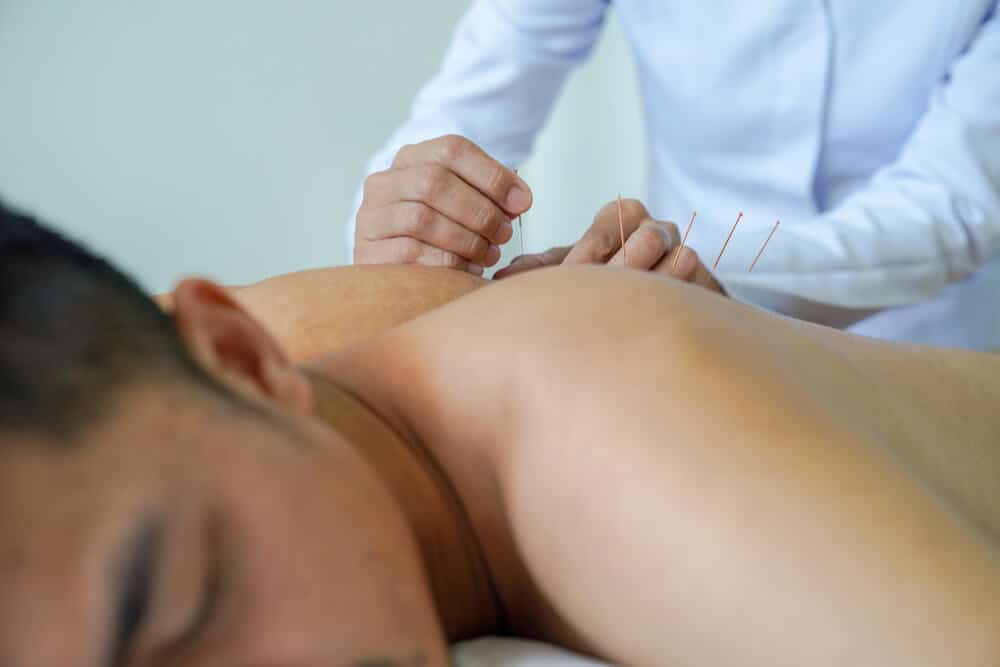Dry Needling Treatment

What is Dry Needling?
Dry needling is a treatment technique that uses micro-fine, single-use, stainless steel needles to reduce pain and relieve tension. These needles measure around 0.25mm in diameter.
It is known as “dry” needling because the needles used do not inject any fluid into the body.
During the course of your treatment, your physiotherapist may incorporate techniques such as dry needling to help with muscle relaxation, relieve muscle pain and restore normal muscle function.
If you are experiencing muscle soreness or tightness – or both – dry needling may be an effective treatment for you.
The Dry Needling Process
Before undertaking any physiotherapy treatment, your physiotherapist will examine any symptomatic areas, discussing the aches or pains you are likely experiencing.
In order to relieve the tension and painful knots, as well as any referred pain, your physiotherapist will ask you to relax, before inserting a micro-fine needle or needles into any trigger points within the soft tissue.
Depending on the extent of the pain or tension, the practitioner may choose to leave the needles in the trigger points for up to 10 minutes.


How Does Dry Needling Work?
As the micro-fine needle is inserted into the myofascial trigger points (knots in the muscle), there are several mechanisms that are believed to be at work, resulting in decreased pain and tension.
One way that this form of treatment is believed to work is through the stimulation and blocking of receptors. The dry needle stimulates the A-delta nerve fibre, which blocks the C nerve fibre from communicating with the spinal cord, which blocks the pain message from the sore area. This is known as pain-gating. The insertion of the needle into the trigger point also stimulates a local twitch response (LTR) which causes a strong contraction of a small section of the muscle, stimulating the local spinal reflex arc and ultimately relaxing the muscle. This process is also understood to release analgesia, known as endogenous opioids, as well as anti-inflammatory mediators.
The application of dry needling also causes a small increase in blood flow to the treatment area, which may promote healing.
The result is that the myofascial trigger point relaxes and the referred pain ceases, with some patients experiencing instantaneous results.
Is The Needling Painful?
Overall, dry needling is a comfortable and very effective technique for the majority of patients.
As with all treatments performed on patients, our physiotherapists will assess each person on a case-by-case basis to determine whether dry needling is a suitable treatment option.
Dry needling is commonly used to treat pain in the neck, shoulders, arm, elbow, lower back, glutes, legs, knees, calves, ankles and headaches.

Other FAQs
Is Dry Needling Safe?
When performed by a trained physiotherapist, dry needling is a safe treatment option.
However, everybody responds differently to treatment and as such, there may be side effects of the treatment. Although uncommon, some side effects are:
- Nausea
- Fainting
- Bruising or spotting
- Discomfort
- Changes to energy levels
Side effects from dry needle therapy should last no longer than 24-48 hours. If you experience symptoms beyond this, please see your doctor or health professional.
How Many Dry Needling Treatments Do I Need?
Given that is takes time to develop an active and painful trigger point, it is worthwhile remembering that fixing the issue can also take time. Some patients may require several treatments to completely resolve their pain or tension, with dry needling often used in combination with other physiotherapy techniques such as massage, joint mobilisation, exercise prescription and taping. Often the reason for developing the myofascial trigger point is muscle imbalance in an area – that is some muscles are overworking and tight, and some muscles are not working enough. To ensure your trigger points and pain doesn’t return, your physio will address any contributing factors.
Is Acupuncture the Same as Dry Needling?
While both acupuncture and dry needle therapy utilise needles to improve a patient’s wellbeing, they both have different uses.
The practice of acupuncture has its roots in traditional Chinese medicine, with practitioners believing that stimulating acupuncture points can improve the patient’s qi (vital energy) and allow this qi to flow uninterrupted along the pathways between acupuncture points (known as meridians).
However, dry needling occurs at the site of the pain or tension and involves needles being positioned directly into the soft tissue that is experiencing issues.
What if I Have a Fear of Needles?
However, the needles used for dry needling are nothing to be fearful of – they are only 0.25mm in diameter! Our patients often report experiencing no discomfort at all during their dry needling treatment.
If you do have a phobia of needles but would like to give dry needling a go, our physiotherapists will do their best to alleviate your concerns and minimise any potential discomfort.
Book Your Dry Needling Appointment in Miami & Lakelands
Whether you haven’t seen a physiotherapist before or you’re looking for someone new to help with your aches and pains, you can trust the physiotherapists at Miami and Lakelands Physio to get your body back on track.
Our experienced physiotherapists want to ensure the best outcome for you as our patient, so every precaution is taken to guarantee you are comfortable, relaxed and prepared for the treatment.
Contact Miami or Lakelands Physio today to book a consultation with our physiotherapists and find out if you are a candidate for dry needling.
Blogs that you might find interesting:

